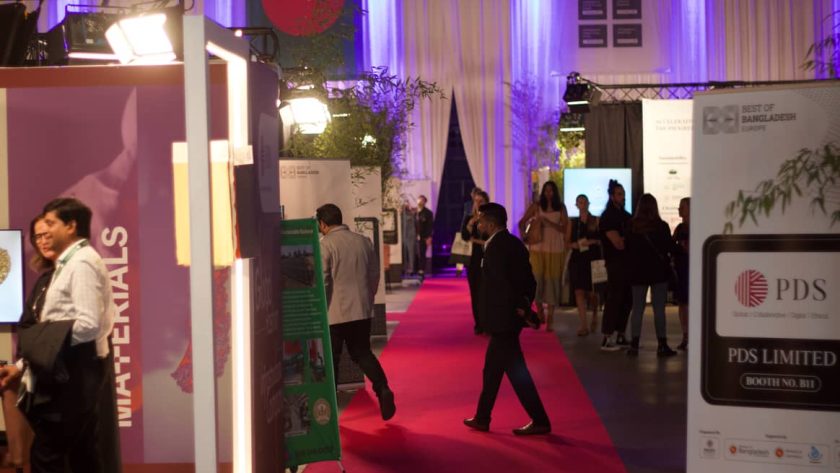The first edition of Best of Bangladesh (BoB) came to fruition this month. On September 4-5, the Gashouder Westergas in Amsterdam flooded with professionals from different sectors to celebrate five decades of trade between Europe and Bangladesh.
The event, organized by the Bangladesh Apparel Exchange (BAE), looked to revolutionize the image of the key manufacturing country, which has been tainted in the past by the fire at Tazreen Fashions (2012), the collapse of Rana Plaza (2013), and a race to the bottom around textile workers’ wages. BoB showcased a country with a booming economy and huge potential.
Exhibitors represented Bangladesh’s vast economy, from pharmaceuticals and food sectors to the digital industry. However, the main focus was on innovative and sustainable parties from the garment and textile sector – including leather and jute. FashionUnited visited the fair to explore the atmosphere and assess the state of affairs.
Networking fair with Bengali promotion
Visitors’ interests at BoB varied widely, but it was evident that business was not the first priority; in fact, few buying parties were present. Networking and orientation took precedence. “In Bangladesh, they are very focused on their image, and this is a beautiful place,” said a representative from industry organization IAF. “Instead of just ‘coming along’ to Kingpins, Bangladesh is now putting on its own event. I think that statement is strong.”
Corporate Social Responsibility (CSR) manager Ellen de Jong was attending the fair on behalf of JOG Group, which produces in Bangladesh. “I think it is very good that this event exists, especially in view of the developments in sustainability that are moving quickly. It becomes clear here again what needs to be done and that we, as a brand, need to engage in conversations with our suppliers.”
An anonymous design agent who has been doing business with Bangladesh for 30 years said they have seen many positive developments at production sites. “Things are not so different in Bangladesh anymore than in manufacturing countries like India. I think there are a lot of misconceptions about this in society.” Among the professionals, there were also proud expats in attendance like volunteer Aditree Amin. She spoke about the typical Bengali craftsmanship on display, such as Hogla weaving and embroidered quilts known as Nakshi Katha. National dance, art, and music also emphasize the cultural element that makes BoB unique.
There was also a certain reserve among exhibitors. For example, they let little slip about the price point of sustainable versus conventional options or the extent to which major brands are investing in those sustainable technologies. Innovation, however, was talked about enthusiastically. For instance, Xavier Gratiean of Suad Garment Industries spoke proudly of the company’s modern machines used specifically for formal tailoring for brands like Next and Guess. The group behind the company, Shin Shin, is committed to sustainable energy and water use, according to Gratiean.
A contact at Denim Expert spoke of an in-house recycling facility that allows 30 percent (pre-consumer) blending. “It is slightly more expensive, but many of our customers still choose this option – including the big mass-produced brands,” they said. This trend was confirmed by Hasan Rahat of Pacific Jeans, a large jeans company with a production of 120 thousand pairs per day. But he also admitted that brands like Inditex and H&M sometimes drop out due to the price difference. Mohammad Mohammad Monirozzaman of Jamuna Denims Weaving spoke positively about Jeanologia’s innovative Ozone, Eflow, and Laser machines, which assist the denim supplier in saving water and energy.
The vendors present from the Bengal readymade garments (RMG) industry also gave an insight into the new wave of green LEED certified factories that Bangladesh has hosted since this year, totaling 200. Nevertheless, the reality remains somewhat of a black box, as the remaining three to seven thousand factories are not represented at BoB.
Calls for better perspective for factory workers
The fair atmosphere is briefly interrupted by an intervention by the Schone Kleren Campagne (SKC) / Clean Clothes Campaign (CCC). Advocates stand up in a packed auditorium to make the interests of factory workers known, as no unions have been admitted to the fair. “Shame,” said one of the activists. The catalyst for this action was the killing of Shahidul Islam, a Bangladeshi union leader who was recently murdered following negotiations regarding unpaid wages. Furthermore, discussions at the national level are forthcoming. The Foreign Minister of Bengal announced during BoB a wage review scheduled for the end of 2023 – the first in five years. The BoB organization is hesitant to comment on the absence of unions.
Campaign Coordinator at SKC, Christie Miedema, believes that more pressure needs to be applied. “A lot has changed in the factories falling under the International Accord in terms of safety since 2013. Child labor is not the most common issue either. This doesn’t mean there aren’t other significant problems deserving attention, such as the low wages of adult workers. The government plays a crucial role in improving the environment for independent unions in Bangladesh: the barriers to registering independent unions need to be lowered, and the process needs to be more transparent.
“Factories should ensure that independent union organizers have access to workers. Currently, so-called ‘yellow unions’ loyal to management often pose a significant barrier. For brands, it’s extremely important that they express their appreciation for independent union activity in factories. Fair prices are also part of the solution. As long as brands primarily come to Bangladesh for low wages, factories will continue to prevent workers from demanding higher wages, and the Bangladesh government will have no reason to improve freedom of association.”
Clearly, this problem cannot be blamed solely on Bengali suppliers. Due to their subordinate position in the chain and competitive market, they are dependent on legislation, collaborations such as the International Accord, and the purchasing practices of brands that can give them more leeway.
Bangladesh is the world’s second-largest exporter of garments. Almost 80 percent of the country’s total export earnings come from the RMG industry, and Europe has a large share in it. With a volume of 1.33 billion kilos of garments sent to the EU last year, the country overtook China (1.31 billion kilos), the former number one. Between 2015 and 2020, European brands ordered 14 percent more annually from Bangladeshi suppliers. The biggest buyer was Germany with 7.28 billion in orders in 2022, followed by Spain (3.27), France (2.74), Italy (2.01), Poland (1.83), and the Netherlands (1.7).
That economic growth has everything to do with the country’s favourable trade position, we learn from Rensje Teerink, European Union Deputy Director EEAS Asia-Pacific. Currently, Bangladesh is one of the ‘Least Developed Countries’ (ldc), but it will leave that status behind in 2026. Teerink said: “Currently, the Everything but Arms (EBA) regime allows Bangladesh to export anything but arms to Europe without tariffs and quotas. No country has benefited as much as Bangladesh: at least 60 percent of all merchandise entering Europe under EBA comes from Bangladesh and that is mostly textiles.
“If they ‘graduate’ to a developing country, they are no longer allowed to participate in EBA and those will be lost. After a three-year phase-out period, they then have to join the Generalised Scheme of Preferences Plus (GSP+) which will also makes it harder for them to export. We still need to see the exact rights they will receive because that legislation is not yet finalized, but the conditions are stricter, especially in the area of human rights.”
To continue receiving support from the EU under GSP+, Bangladesh must also adhere to regulations. Once again, this raises concerns about poor working conditions. After a panel discussion on this topic, former development cooperation employee Jos Huber poses a critical question: “When does the EU believe that Bangladesh has made sufficient efforts to address labor rights violations? The commission can take action, but in the entire GSP system, I can recall only two situations, not related to Bangladesh, where those fiscal benefits were suspended.”
There are still many uncertainties, but from 2029 onwards, it will become less easy for Europe’s largest clothing exporter. Improvements in social and environmental areas are required for smooth trade continuity.
Whether BoB provides a realistic and comprehensive picture of progress in Bengali clothing production remains uncertain, but the message of the fair is clear: to address the systemic challenges of the clothing industry, governments, brands, suppliers, and unions must continue to collaborate.
This article was originally written for FashionUnited.nl before being translated and edited to English.



